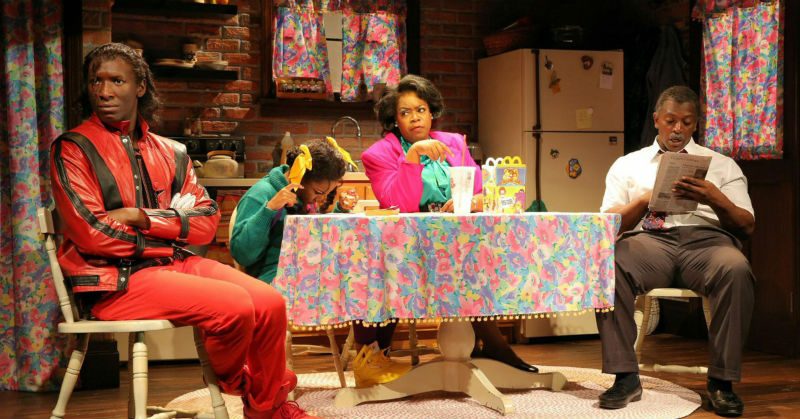BootyCandy” is a thinly veiled coming-out story of growing up African American and gay.
For many LGBTQs across the nation-especially those of us of African descent-we have been breathlessly waiting for Robert O’Hara’s BootyCandy to come to our cities. BootyCandy has finally come to Boston, and each show has been a sold-out performance.
BootyCandy is O’Hara’s thinly veiled coming-out story of growing up African American and gay. And the narrative is told in the voice of the character named Sutter. O’Hara takes the audience on a journey through his childhood home, church and gay bars that’s depicted with excessive flamboyance, ribaldry, and unsettling poignancy.
“BootyCandy is a non-linear narrative comprising of disparate vignettes that’s “difficult for you to find a narrative in this play until the end, and it’s done that way on purpose,” O’Hara told WBUR reporter Jeremy D. Goodwin in an interview. The structure of the play is a nod to George C. Wolfe’s The Colored Museum, which O’Hara admits was a huge influence.
The play opens with a precocious Sutter querying his mother about his genitalia. Showing her unease in having an explicit sit-down conversation with Sutter about his sex parts, the mother euphemistically tells him that his penis is called “bootycandy.”
Sutter is a gender non-confirming effeminate male decked out in full Michael Jackson regalia, complete with one sequined glove.
The mother’s unease to talk about sex and to accept her son’s gender expression is disturbingly highlighted when Sutter comes home one day from school to inform her that a man has been following him. Because of the “politics of silence” in the African American community that chokes a healthy conversation on human sexuality Sutter’s mother is not only dismissive of his claim she immediately wants to know what Sutter did to provoke such an unsavory encounter.
Her solution, however, for her son’s unmanly behavior is for him to stop reading Jackie Collins novels, stop listening to Whitney Houston albums, and stop participating in the school’s musicals. The scene is absurdly funny yet poignantly disturbing.
And just when you think you cannot laugh anymore, there’s the vignette with the hilarious telephone scene between two actresses who play a group of sisters on a phone, one of whom is pregnant and determined to name her baby Genitalia. (I personally enjoyed this scene because it reminded me of when one of my sister-friends was determined to name her new born baby girl Uretha, in honor of the Queen of Soul, Aretha Franklin.) In a later vignette Genitalia is all grown up, a lesbian and standing before a minister with her soon to be ex-girlfriend, Intifada, in an official break up “non-commitment ceremony.”
The lesbians’ “conscious uncoupling” (Not my term. It’s Gwyneth Paltrow’s in announcing the separation and then divorce of her spouse, Chris Martin.) vignette is a holds no barred repartee that in the end leaves both women utterly and irrevocably each other’s exes.
You cannot be LGBTQ of African descent and not have a personal yet all too familiar narrative about black church homophobia. O’Hara’s Reverend Benson is your assumed classic fire and brimstone exhorter, especially with his “call and response” homily. But Benson has a secret of his own.
Preaching a black queer liberation theology that excoriates the church’s gossip mongers (the “I Heard Folks” who congregate and become the “They Heard Folks”) in defense of its gay choir boys, Benson finally discloses his secret by disrobing and revealing what’s underneath his vestment.
While homophobia is a running thread in many of the vignettes, particularly the Black Church and black cultural brand of it, the story line makes you laugh to keep from crying in order to look at hard and unresolved issues a young gay black male coming out confronts, like racism, homophobia, sexual abuse, rape, poverty to name a few–and at their intersections–and how that might shape one’s self-esteem and further social sexual relationships.
I surmise the best way to depict BootyCandy is to call it a tragicomedy, a play that uses humor and comedic moments to obfuscate not only one’s painful personal journey of coming out, but, also, one’s unresolved pain and trauma from sexual abuse. One of the dark and most disturbing moments in the play is the last of several gay bar cruising scenes. Sutter and his friend pick up a drunken white “supposedly straight” male who solicit the two men to follow him home to sexually humiliate him. Sutter’s eagerness and cold indifference to fulfill the man’s request disturbingly suggests both racial and psychosexual revenge for his childhood sexual seduction by an older white man.
In the vignette “Conference” there is a mock panel discussion between four African American playwrights, each of whom has written one of the previous vignettes the audience has seen, and a clueless white moderator who condescendingly asks the writers, “I’m wondering what you are hoping the audience comes away with after seeing your work?”
Sutter: I think the audience should choke.
Moderator: Choke?
Sutter: Asphyxiate.
WRITER 1: I don’t want them to digest it easily.
And BootyCandy isn’t easy to digest.
You leave BootyCandy knowing O’Hara’s journey was difficult -like that of so many LGBTQ of African descent. O’Hara didn’t touch on HIV/AIDS ravaging our communities, and the Black Church continued silence on it. O’Hara masterfully shows that only through humor could the absurdities of black homophobia keep you laughing from crying.
